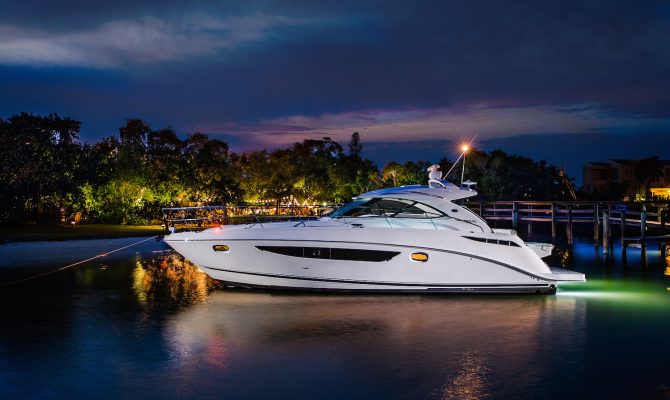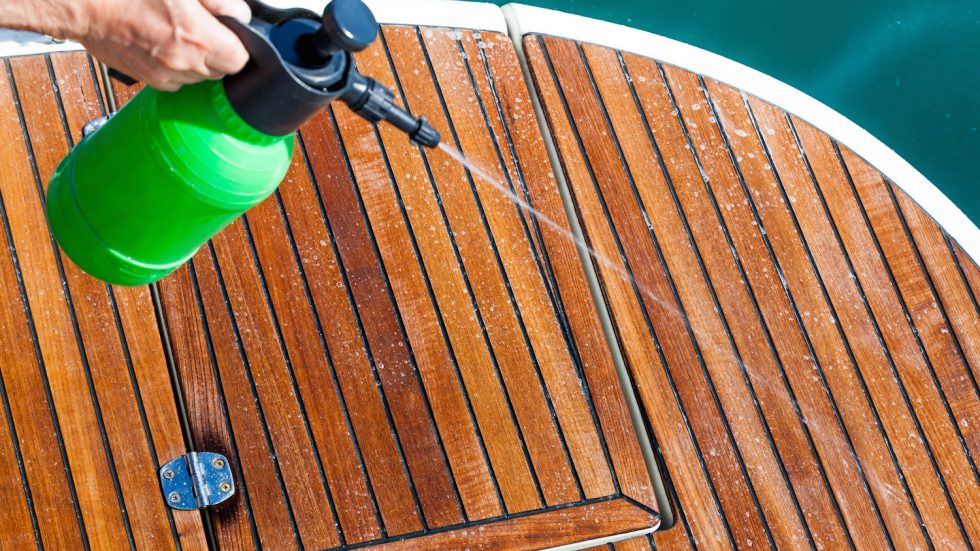Steering Director/Cross-Track
About that “Go To” button: Technically, that concept would work great in a car or truck. You know, where tires stick to the road and prevent you (hopefully) from sliding sideways? The water doesn’t work that way. Being a fluid medium, numerous other dynamics, like current, waves and wind act upon your vessel while underway. Ergo, rarely can you enjoy the luxury of driving a straight line between two points. And when you don’t, it costs you time and money.
That’s where your steering director or cross-track error function comes in handy. Ever watch those YouTube videos of airliners landing in a strong crosswind? It looks like they almost fly sideways until they actually touch down. In fact, that’s exactly what they’re doing. The pilot angles the plane to counter-balance the sideways force, called crabbing.
That’s exactly what your cross-track error function does for you. Not only will it tell you how far to the right of left of your intended course you’ve strayed, but the steering director provides you with a heading that counterbalances the forces of evil pushing you away from your desired destination. It measures your set and drift and calculates the proper heading, and if you steer that, despite the fact that your bow may be pointing to the right or left of your destination, you’ll ultimately travel a straight line to your goal.
No more Great Circle Route or repeated presses on “Go To.” With steering director/ cross-track error, it’s one and done.
Anchor Alarm
Sleeping aboard at anchor, especially when a rare occurrence, can often serve up a poor night’s sleep. There, in the back of your mind, you wonder if your anchor might have dragged. Have you gotten too close to that boat next to you? Are your boat or family in peril? No wonder you can’t sleep soundly!
Your chart plotter has a handy fix for that called an anchor alarm! Tell your plotter how far from your present location you are willing to swing. The display will draw an electronic circle around your boat. If, for any reason, your vessel strays outside of that circle, the unit sounds an alarm and you can deal with the issue immediately.
If it remains silent, you can remain fast asleep, secure in the knowledge that all is well.
Depth Sounder Waypoint
Returning to your favorite fishing spot used to be much harder. When you found such a place, you recorded its geographic position on your Loran or GPS. When you returned, inevitably you spent some time searching the area with your sounder to find exactly the right spot. No more! Nowadays, when you find a specific piece of ground, structure or whatever, you can place the cursor of your sounder on the image of that structure on your display and save it as a waypoint. Return to it immediately time after time. Combine that with route tracking, and you can set up grid patterns to fish it or monitor your rate and direction of drift — always returning to the exact spot at will!
DSC Communications
Most VHF radios today come with DSC (Digital Selective Calling) built-in. Once you apply for and receive your MMSI (Maritime Mobile Service Identity) free from BoatU.S., the marine communications world becomes your oyster.
The initial concept addresses safety at sea: Your MMSI contains loads of information about you, your boat and your emergency contacts. This info gets programmed into your radio, so that in an emergency, you can push a single red button and all that information flies to the nearest Search and Rescue asset. Great insurance.
But wait, there’s more! DSC allows for discreet communications between cooperating vessels. For example, you and two friends on your respective boats head out for a day of fishing. Only one of you finds the “once-in-a-lifetime” hot spot. You’d like to call and invite them to join you, giving them your coordinates, but then the whole world will hear — and goodbye private hot spot.
With DSC, you can dial in your friends’ MMSI numbers, and when you call them, nobody else can hear what you’re saying. To them, it’s just electronic noise.
Caveat Emptor: MOB Button
Here’s the problem with using it for its intended purpose. You’re cruising along, and someone quietly falls overboard. They may take some time to gather their wits enough to shout and wave. By that time, at 30+ mph, you’re quite a distance away. When you realize you’ve lost someone, you punch the button. But, it bears no resemblance to where the person went in.
Or, perhaps you’re cruising in an area with currents, wind and waves. Even if you see the person accidentally go swimming and press the button immediately, by the time you turn around and get back to where they splashed, they’re no longer there. The MOB function registers a geographic position that does not move. But the victim does move, sometimes quickly.
In other words, beware and follow the old-fashioned MOB protocol as well.
Author: Dean Travis Clarke is a regular contributor to HeartLand Boating magazine




